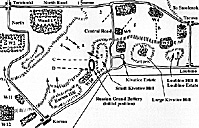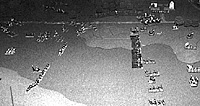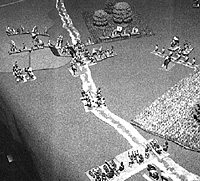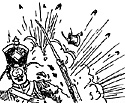This scenario places us at the beginning of the invasion of Russia in 1812. Barclay de Tolly is trying to retreat toward Smolensk via the road from Korma and Tacova. At Tacova, the road continues toward Smolensk.
The French Mission
Napoleon learned that Barclay de Tolly is trying to retreat his large command toward Smolensk. He ordered Davout to dispatch part of his Corps to cut off the Russians from Smolensk.
Consequently, Davout detached part of his Corps under General Raiff to intercept the Russians. Raiff's command included two Divisions (four brigades), a cuirassier Division and two light cavalry brigades. Raiff's mission was to prevent Barclay from retreating and cut him off. However, he had only a short time to do so. He knew that if the Russian 4th Division reached the battlefield before he defeated the other three Russian Divisions, his chances of success were practically nil.
A captured dispatch informed General Raiff that Barclay de Tolly had learned that the road to Smolensk from Loubino was cut off because of the destruction of the bridge on the River Beresina at Malouki. Hence the only Russian line of retreat was through Tacova.
The Russian Mission
At 12:30, the Russian cavalry advance guard, which had been vigorously screened by the French cavalry, reported that a numerous French force of corps size, including cavalry and infantry, had been spotted at Tarouki.
At that time, Barclay had most of his command scattered in columns of route on the road from Korma to Tacova. His 1st Division had reached Tacova, the 2nd Division was around the Kivatice estate followed closely by his Reserve Artillery. Just behind the guns followed the cuirassier Division of General Valence. The 3rd Division was going through Korma. His light cavalry, the Elizabethgrad Hussars (eight squadrons), was deployed behind the small Kivatice woods.
So much for the Russian deployment. Barclay de Tolly could easily extricate himself from the French by withdrawing his command and fighting a classic rear guard action with his light cavalry and his 3rd Division. However, there was a problem. His 4th Division had fallen behind and wouldn't reach Korma until 19:00 (7 p.m.) at the earliest. Barclay had no choice but to keep the road from Korma to Tacova open until the 4th Division appeared. Then, as soon as the 4th Division reached Korma, he could start to withdraw his entire command.
Sunset would be at 21:00 (9 p.m.).
As soon as he received the cavalry report at 12:30, Barclay called his Division commanders to discuss his battle plan. Barclay ordered his Division commanders to hide their troops for as long as possible from the enemy in order to gain as much time as possible.
The Combat at French Deployment
 As we saw at 12:30, a Russian cavalry detachment had spotted the French force at Taratouki. At 12:40, General Raiff began to deploy his troops, but, unaware of the Russian whereabouts, issued orders to send several cavalry patrols to locate the Russians. These patrols were on their way at 13:00.
As we saw at 12:30, a Russian cavalry detachment had spotted the French force at Taratouki. At 12:40, General Raiff began to deploy his troops, but, unaware of the Russian whereabouts, issued orders to send several cavalry patrols to locate the Russians. These patrols were on their way at 13:00.
Large Deployment Map (slow download: 94K)
Raiff planned to cut off the road to Smolensk somewhere around Tacova. Consequently, his left wing commander was to attack the Russian position around Tacova and between Tacova and the Kivatice Estate with three brigades. Meanwhile, the other two would neutralize the Russians and prevent a flank attack. Speed was essential to success.
At 13:00, the French left wing started to progress toward Tacova with an infantry brigade flanked (arrow 1) by a Light Cavalry brigade (arrow 2). A second brigade followed. Then between 13:00 and 13:20, another French infantry brigade (the center brigade) appeared on the small plateau near the Taratouki woods (see arrow 3) and moved toward the Small Kivatice Hill.
That brigade was flanked by another French Light Cavalry brigade
moving toward the Korma Hill (see arrow 4). [1]
At 13:20, the 1st French cavalry brigade (nine squadrons) reached the central road and at the same time, the Russian light brigade that was hiding behind the Small Kivatice
Woods, came out into the open and deployed in two lines of four squadrons each. Both French and Russian cavalry brigades unlimbered their supporting artillery batteries. Their respective
lines of deployment are marked on lines 2 and 5. The French deployed in three lines of three squadrons each.
The artillery of both the French and Russian cavalry brigades deployed on or near the central road opened fire.
The squadron of French cavalry was followed by a cloud of skirmishers. French skirmishers also deployed in the French center as far as the Small Kivatice Woods. They spotted another
Russian battery on the north part of the Small Kivatice Hill.
A Russian cavalry patrol probed the French right (arrow 6) and found that flank free of French troops even behind the Taratouki Hill. [2]
First Blood
13:40: It was now time to draw first blood! After another discharge of artillery, both cavalries near the central road charged each other. A brief combat (10 minutes) took
place and the French 1st line (three squadrons) was repulsed by the four Russian squadrons. The French withdrew in order to reform behind the 3rd regiment. [3]
In the center, two French battalions in columns of divisions attacked the northern part of the Small Kivatice Hill occupied by two Russian battalions supporting a battery. The
second Russian battalion on that hill charged down the hill to push back the French skirmishers, which withdrew. The Russian battery limbered and withdrew just before the northern Russian
battalion was attacked both in front and flank by the two French battalions. The Russian battalion was routed. The second Russian line deployed in front of the Kivatice woods and in the gap between that wood and the southern part of the Small Kivatice Hill held firm.
A firefight developed in front of the Kivatice
woods (W8) as the French battalions, which had just captured the Small Kivatice
Hill faced an imminent counter-attack by much superior Russian
forces, retreated to their starting position.
The lone Russian battalion (arrow 7) that had
pushed back the skirmishers continued its march onto the plain
and the French skirmishers continued to withdraw. However, two
French battalions, which were part of the French supporting brigade,
received the order to deal with that lone Russian battalion.
14:00: On the plain, the lone Russian battalion
now faced the two aggressive French battalions which charged (point 8).
After a short combat the Russians were routed and quickly
withdrew behind the Small Kivatice Hill. [5] The Russian second line which witnessed the rout held firm.
The Russian 3rd Division, holding the southern part of the road, had been ordered to move its position down toward the plain, apparently to menace the French right flank. It started
moving in two lines of columns.
The French brigades progressing on the north road toward Tacova were now in position to attack the Russian infantry that had advanced from Tacova and had deployed a brigade on each
side of the Small Tacova woods on line A.
Each Russian brigade was supported by an artillery battery. The first brigade on the north part of the road was deployed in two lines. Two battalions in column were
deployed on the second line. One battalion was deployed in the edges
of the Small Tacova Woods (W4) and the other on the north of the
woods with the artillery battery.
The second brigade south of the woods had
deployed its four battalions on a single line of battalions in
column at deploying distances (line B). The battery supporting
that second brigade was unlimbered in the center, i.e., with two battalions
on each side. The Russian Division commander with his brigadier
watched the French infantry very closely that had come out of the
North woods (W3). It was clear that the French were ready to
attack on that sector, but the Russians were ready.
The French had come up the northern road. Two
battalions in columns of divisions were aligned with the western part of
the North woods. They were supported by two batteries and three
other battalions also in columns of divisions in the second line.
At the same time, two battalions of the 15th Léger emerged from
the North woods (W3). The second battalion was busy reforming
while the 1st battalion remained in skirmish order. Of course,
the artillery of both sides opened fire.
14:10: The French on the northern road
immediately moved forward to attack the Russians from a line
approximately some 900 yards from the Russian position. The
Russian battery continued its firing as the French moved up. At
that time, the Russian Division commander who was with the 2nd
brigade commander south of the Small Tacova woods (W4) (which was
deployed on line B) seeing the French moving forward decided to
attack them with two of his closest battalions. He issued orders
for that purpose.
In the center, the French artillery fired in the Small Kivatice woods which they knew was occupied by some Russian infantry.
14:20: In the center, Raiff ordered his closest
brigade to fall back outside the range of the Russian artillery
grand battery. The 3rd Russian Division continued its forward
march on the French right flank and was now deployed on lines C
and D. (See Photo 2, which clearly shows the situation on that
flank.)
The French attacked the Small Kivatice woods
(W9). A violent combat took place in that woods and after a 30-minute combat,
the Russians were finally defeated (major defeat) . (End of
combat at 14:50.)
In spite of the Russian artillery fire, the two
French battalions on the northern road now came in contact with
the Russians. But the two Russian battalions of the 2nd brigade
still in column that had been ordered to attack the French right
flank came into play. The 1st Russian battalion pushed
back the 1st battalion of the 15th Léger that was in skirmish
order and charged in flank the right French battalion (See Photo 3).
The second Russian battalion, still in column, charged the 2nd battalion of the 15th Léger that had just enough time to wheel into line. But that French battalion was also hit
by the fire.
Furious Combat
Strangely enough, the French cavalry commander on the center road did not continue to charge the Russian cavalry and the Russians also remained in their position. Upon noticing this
lapse, Raiff rode over to the cavalry commander and ordered him to resume the offensive.
14:30: The French brigade on the French right flank held its position while the Russian infantry of the 3rd Division aligned itself with the grand battery. A French battalion informed Raiff that Russian cavalry had moved into the gap between the Small Kivatice Hill and the Kivatice Estate.
Orders were issued to the French light cavalry to resume the attack. The Russian hussars held their ground.
14:40: Raiff received the messenger informing him of the repulse of his infantry on the Northern road. The situation was now very critical:
Withdraw
Raiff was quick to make up his mind. He felt that after being repulsed on the northern road he could not reach his objective in time with the number of troops available before the Russian flank attack wore down his forces. Consequently, he immediately issued orders for his troops to disengage and to begin to withdraw.
Barclay de Tolly took some time to realize that the French were withdrawing and not redeploying their troops. He was only too happy of the developing situation. After all, his orders were to extricate his command and to continue his retreat with minimum losses. This he had done rather well.
The French had a very difficult battle to fight successfully with a relatively small effective strength. They had to move fast which they did, but obviously not fast enough.
Perhaps the cavalry was not aggressive enough to clear the well deployed Russian light cavalry. But was it a cavalry problem?
Raiff's plan was to attack the Russian position between the Kivatice woods and Tacova with his left wing: three brigades (13 battalions and three batteries), while he held the other
Russian forces at bay with his two other brigades. It was a good basic plan but its execution was too slow.
In fact, the French left wing commander did not deploy his troops properly. In addition, his dispositions prevented a quick French deployment. He only deployed two brigades keeping the other to the rear where it did not do any good. With the French cavalry too slow to clear the center, the French left wing was bottled up and, as we have seen above, was very slow to
deploy.
Perhaps only one brigade should have been sent to attack the Russians on the northern road while his second brigade moved in the gap between the Central woods and the Small Kivatice
woods (the Gap hereafter). Granted, the center was occupied by the Russian light cavalry, but that cavalry was no match for five fresh battalions of elite infantry, formed in square and making a slow advance, with artillery support and backed up by nine squadrons of cavalry. Anyhow, that would have been a far quicker alternative than passing several battalions through the Central woods. Remember time was critical.
The French commander was not blameless either. As he witnessed:
Deployment
Once more, the point we have made in several past battle reports is well illustrated. A good initial deployment is essential to victory. If the attacker deploys and concentrates his attacking forces quickly on a given point before the enemy can concentrate his, the attacker is almost sure of winning the contest.
Let us not forget that the Russian forces, if
they had an excellent defensive position, were stretched to the
limit, especially between the Kivatice woods and Tacova. If their
first line had been broken through, they had no second line to
counter attack or repair the damage. In case of a French
breakthrough, the Russian situation would have been critical.
The Russians deserve a pat on the back. Their
deployment, imposed by circumstances out of their control, was good. The
positioning of their grand battery, coordinated with the advance
and deployment of their 3rd Division, was excellent and a
decisive turning point in the battle.
However, tactically speaking, a question comes to mind. Why was a single battalion sent down the Small Kivatice Hill (to push the French skirmishers back) pushed too far? That battalion
in pushing back the skirmishers had done its job, so why sacrifice it? Its forward movement past a certain point did not bring anything additional to the Russians. In fact, it did the
contrary and the result was a routed, depleted battalion. That is certainly not an instance of the recommended policy of "economy of force."
Forces at the Combat of Kivatice
![]() A great deal was about to happen by 12:30. The French center brigade in columns of divisions continued to advance toward the Small Kivatice Hill where a squadron of French cavalry
uncovered a Russian artillery battery supported by infantry, which had been hiding behind the Small Kivatice Hill. The Russian artillery battery immediately unlimbered and the French squadron quickly withdrew to avoid its fire.
A great deal was about to happen by 12:30. The French center brigade in columns of divisions continued to advance toward the Small Kivatice Hill where a squadron of French cavalry
uncovered a Russian artillery battery supported by infantry, which had been hiding behind the Small Kivatice Hill. The Russian artillery battery immediately unlimbered and the French squadron quickly withdrew to avoid its fire.
 13:50: The victorious Russian cavalry on the center road pursued the defeated French but, disorganized by its combat and pursuit, was intercepted by the three fresh French squadrons of
the second line. After a rather lengthy and furious combat lasting 20 minutes, the more numerous but disorganized Russians were repulsed (minor defeat). Both French and Russian squadrons
withdrew behind their second line to reform. [4] (The combat was to last until 14:10.) (See Photo 1.)
13:50: The victorious Russian cavalry on the center road pursued the defeated French but, disorganized by its combat and pursuit, was intercepted by the three fresh French squadrons of
the second line. After a rather lengthy and furious combat lasting 20 minutes, the more numerous but disorganized Russians were repulsed (minor defeat). Both French and Russian squadrons
withdrew behind their second line to reform. [4] (The combat was to last until 14:10.) (See Photo 1.)
 The Russian 3rd Division now in the plain moved
closer to the French right flank and Raiff changed front and now faced
his supporting brigade on the flank southward to face that new
Russian menace. As that movement was taking place, the Russians
deployed their Reserve artillery (three batteries) in addition to
the battery that was already on the Small Tacova Hill thus
forming a grand battery of some 48 guns! (See Photo 2)
The Russian 3rd Division now in the plain moved
closer to the French right flank and Raiff changed front and now faced
his supporting brigade on the flank southward to face that new
Russian menace. As that movement was taking place, the Russians
deployed their Reserve artillery (three batteries) in addition to
the battery that was already on the Small Tacova Hill thus
forming a grand battery of some 48 guns! (See Photo 2)
 Furious combats took place and after a brief ten minutes, the French were repulsed (the 15th Léger suffering a major defeat in the process). The French recoiled to their starting position. The commander of the French left flank immediately sent a message to Raiff informing him of the repulse of his attack.
Furious combats took place and after a brief ten minutes, the French were repulsed (the 15th Léger suffering a major defeat in the process). The French recoiled to their starting position. The commander of the French left flank immediately sent a message to Raiff informing him of the repulse of his attack.
Conclusions
Back to Empires, Eagles, & Lions Table of Contents #12
Back to Empires, Eagles, & Lions List of Issues
Back to MagWeb Master Magazine List
© Copyright 1995 by The Emperor's Press
This article appears in MagWeb (Magazine Web) on the Internet World Wide Web.
Other military history articles and gaming articles are available at http://www.magweb.com
